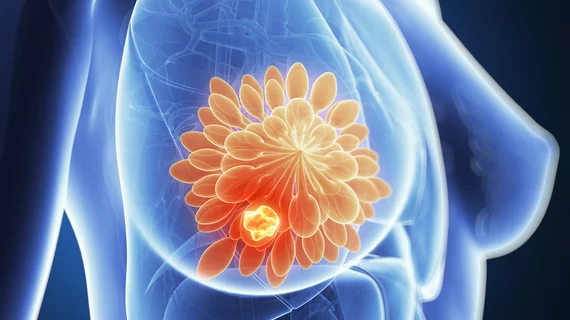Interval breast cancers’ aggressiveness may stem from unique biology, JAMA study finds
Breast cancer detected within one year after previous negative mammography studies appear to be more destructive in nature and it may not be attributed solely to the delayed diagnosis.
Rather, such “interval breast cancers,” as they’re commonly called, may have a uniquely aggressive biology that could require additional actions from radiologists, experts wrote Tuesday in JAMA Network Open. Scientists from several institutions led by Oregon State University reached their conclusions by analyzing data from more than 3,000 patients included in the Women’s Health Initiative.
Veronica Irvin, PhD, and colleagues determined that those with interval breast cancer detected within one year of a negative mammogram had measurably worse outcomes compared to those detected through regular screenings. That included larger tumors, more lymph node involvement, and higher breast cancer-related mortality.
“The poor prognosis for women with IBCs diagnosed within one year after negative mammogram results might not be due to delayed diagnosis but rather to distinct biological characteristics associated with the cancer,” concluded Irvin, an assistant professor in the College of Public Health and Human Sciences at OSU, and colleagues. “For instance, increased lymph node involvement is often seen in IBCs and cannot be accounted for entirely by delayed diagnosis but rather may be due to a unique biology.”
To reach their conclusions, Irvin et al. utilized data from the large-scale National Institutes of Health’s study of postmenopausal women ages 50 to 79. In a population of 3,019, researchers pinpointed 1,050 cases of interval breast cancer. Roughly 31% (or 324) were diagnosed within a year of negative mammography results, while the other 69% (726) were found between one and 2.5 years afterward. Meanwhile, docs detected the other 1,969 cancer cases through regular screenings.
The team deduced that those in the first-year population of 324 had significantly more lobular histologic characteristics, a larger tumor size, and other more severe findings than those detected through normal means. And the 726 detected between 1-2.5 years, however, were not different from those found through regular screening based on prognostic factors or mortality, the researchers detailed.
Irvin and colleagues noted that the higher death rate in the one-year IBC group persisted after adjustments for risk factors.
Their bottom line for radiologists is that women who present with breast cancer symptoms but produce negative mammography results should be recalled more frequently, have a shorter screening period, or undergo imaging from another modality. Those could include ultrasound or MRI, with the latter shown previously to help drop IBCs rates among high-risk populations.
Combining germline genomic testing with breast imaging may also help distinguish indolent cancers from more aggressive forms detected by screening, they added.
“This study adds to a growing body of literature that argues for the development of novel approaches to detect life-threatening cancers currently missed by mammographic screening,” the research team concluded.

